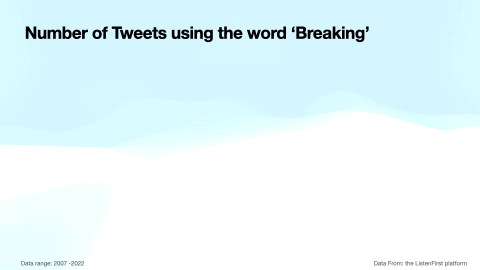How ‘Breaking’ News Is Creating Disinformation On Twitter
The connection between ‘breaking news’ and verification on Twitter
The Twitter verification program started in 2009, and it’s not a coincidence that by percentage, that was the year with the biggest year-over-year increase of Tweets using the word ‘breaking’. The audience was 17X more likely to retweet breaking news content, because there was third-party validation that news outlets and reporters weren’t imposters.
Since then, the volume of ‘breaking’ Tweets has dramatically increased almost every single year, with over 180,000 Tweets using the word in 2022.
However, it’s gotten increasingly difficult to figure out if a breaking news alert is being Tweeted by a credible news source. Twitter began offering paid verification in June 2021, meaning for $8 a month, anyone could buy a blue checkmark and label themselves a Media & News Company.
On April 20, 2023, that level playing field turned to an outright disadvantage for real reporters. Anyone with a legacy checkmark that refused to start paying for it, lost their verification. Most reporters with less than 1 million followers were impacted.
Accounts being tracked
The 300 Twitter accounts Twiangulate identified as most followed by The New York Times employees.
For example, Twiangulate did a 2015 study tracking the 300 Twitter accounts employees of the New York Times most frequently follow. It’s a list primarily of the news organizations and the reporters most respected by their peers. As of June 2023, only 21% of those 300 accounts are currently verified.
The new status quo of verified accounts breaking news
The result is Twitter accounts paying for their checkmark now dominate the conversation around breaking news. Between April 20 - June 26, 2023; 63 of the 100 verified Tweets using the word ‘breaking’ generating the most engagement, came from accounts that got their verification after the date it could be bought.
(Data pulled from ListenFirst.)
The 3 breaking news personas
So if the most popular breaking news Tweets aren’t coming from established journalists at mainstream news organizations, where are they coming from? Here are the 3 types of verified accounts, currently getting the most engagement around their breaking news Tweets.
Persona #1: the misinformation specialist
This persona is about people or an organization who share breaking news Tweets that are based on truth, but change facts that don’t fit the desired narrative.
For example, Leading Report, which only got Twitter verified in February 2023, specializes in conspiracy theories and drawing ridiculous conclusions. Such as focusing on a single page of the George Floyd autopsy report saying he suffered no “life threatening injuries” and had taken fentanyl.
Never mind that the end of that same report concluded he died of “cardiopulmonary arrest,” not a drug overdose, and the breaking story had been debunked three years ago.
Other times, this type of breaking news update changes just one critical detail. For example, Andy Ngô is a writer who specializes in trying to prove trans women are violent and dangerous. He published a breaking Tweet about an attack at a protested drag show in Fort Worth Texas.
There was a real incident but he claimed a suspect was charged with aggravated assault with a deadly weapon. The real weapon was non-lethal pepper spray and the actual charge was assault causing bodily injury.
Persona #2: the activist or fake activist
Advocates or advocate groups often share breaking news Tweets that are factual, but blow up the importance of inane things and see citing sources as secondary or irrelevant.
For example, Occupy Democrats, which calls itself a democratic political organization, got 2 million views for a sexist Tweet about Casey DeSantis and how calling her "Walmart Melania'' was trending. Their Tweet stated Ron DeSantis supporters were melting down over it, and that insiders call Casey "Lady MacBeth" without attempting to back up any of those claims.
Additionally, most Occupy Democrats Tweets end with a plea to use their Twitter competitor. Their real agenda isn’t even about politics.
Another example is Jon Cooper, a Democratic activist, whose breaking Tweets appear solid on the facts. He does however only cite the actual article he’s referring to later in the thread. He uses pictures or gifs in the initial post, because they optimize better than link Tweets.
Persona #3: the fake journalist
This type of verified breaking news poster claims to be a journalist without doing any original reporting. They would be better categorized as political commentators and news aggregators, who in some cases prioritize getting more followers above all else.
Brian and Ed Krassenstein exemplify this persona. The twin brothers were raided by federal agents around financial scams in 2016, which is tangential but speaks to their trustworthiness. They also got banned on Twitter in 2019 after Ed admitted he converted his Justin Bieber fan account into a personal account for the followers. He also got caught on a web forum trying to buy Twitter accounts with more than 40,000 followers.
Now back on Twitter, they call themselves journalists. Their breaking news formula is posting facts about current event stories often without citing their sources, stating their opinions, with the call to action of asking followers for their feedback.
Conclusion
Disinformation has always been a part of Twitter. The difference is now the conspiracy theorists claiming “you should do your own research” are verified and the career journalists are not. You literally need to do your own research because it’s no longer a given that a breaking news Tweet appearing from a verified account contains accurate information.






